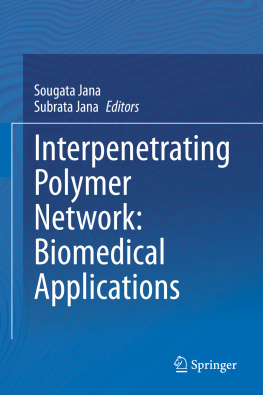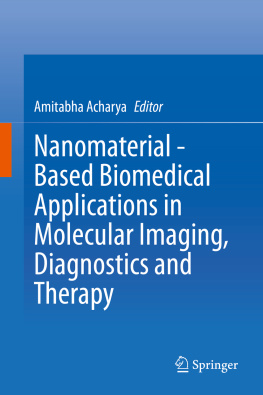Sougata Jana - Interpenetrating Polymer Network: Biomedical Applications
Here you can read online Sougata Jana - Interpenetrating Polymer Network: Biomedical Applications full text of the book (entire story) in english for free. Download pdf and epub, get meaning, cover and reviews about this ebook. year: 2020, publisher: Springer Singapore, genre: Romance novel. Description of the work, (preface) as well as reviews are available. Best literature library LitArk.com created for fans of good reading and offers a wide selection of genres:
Romance novel
Science fiction
Adventure
Detective
Science
History
Home and family
Prose
Art
Politics
Computer
Non-fiction
Religion
Business
Children
Humor
Choose a favorite category and find really read worthwhile books. Enjoy immersion in the world of imagination, feel the emotions of the characters or learn something new for yourself, make an fascinating discovery.
- Book:Interpenetrating Polymer Network: Biomedical Applications
- Author:
- Publisher:Springer Singapore
- Genre:
- Year:2020
- Rating:5 / 5
- Favourites:Add to favourites
- Your mark:
- 100
- 1
- 2
- 3
- 4
- 5
Interpenetrating Polymer Network: Biomedical Applications: summary, description and annotation
We offer to read an annotation, description, summary or preface (depends on what the author of the book "Interpenetrating Polymer Network: Biomedical Applications" wrote himself). If you haven't found the necessary information about the book — write in the comments, we will try to find it.
Sougata Jana: author's other books
Who wrote Interpenetrating Polymer Network: Biomedical Applications? Find out the surname, the name of the author of the book and a list of all author's works by series.
Interpenetrating Polymer Network: Biomedical Applications — read online for free the complete book (whole text) full work
Below is the text of the book, divided by pages. System saving the place of the last page read, allows you to conveniently read the book "Interpenetrating Polymer Network: Biomedical Applications" online for free, without having to search again every time where you left off. Put a bookmark, and you can go to the page where you finished reading at any time.
Font size:
Interval:
Bookmark:


This Springer imprint is published by the registered company Springer Nature Singapore Pte Ltd.
The registered company address is: 152 Beach Road, #21-01/04 Gateway East, Singapore 189721, Singapore
The book focuses on novel interpenetrating polymer networks (IPN)/semi-IPN technology for drug delivery and biomedical engineering. Interpenetrating polymer networks (IPN)/semi-IPN technology is a simple and feasible method to fabricate nanomedicine, hydrogels, nanoparticles, microparticles, etc. in which hydrophilic polymer chain permeates another cross-linked polymeric network without any chemical bonds between them. Generally, IPNs are synthesized for the purpose of combining individual properties of two or more polymers. In some cases, entirely new properties are exhibited by the IPN that are not observed in either of the two single networks alone. The design and development of interpenetrating network polymers is attractive because IPNs provide free volume space for the easy encapsulation of drugs in the three-dimensional network structure, which are obtained by cross-linking of two or more polymer networks. Natural polymer-based IPNs can deliver drugs at a controlled rate over an extended period of time. In majority of the cases, single polymer cannot regulate the drug release rate and therefore, the formation of interpenetrating network appears to be a better approach. It is reported that the formation of IPN can preserve the characteristics of each network structure and improve the stability of materials because of the interlocked structure in the cross-linked networks, thus ensuring better mechanical strength and sustained/controlled drug delivery properties.
The purpose of the book is to highlight recent advancements in some novel IPN/semi-IPN-based systems, potential for drug delivery and biomedical applications.
Nowadays, natural/synthetic biopolymer-based particulate systems are gaining huge attention from researchers due to their immense applicability by exploiting a green approach with minimum toxicity.
The book contains different chapters emphasizing drug delivery and biomedical perspectives of different kinds of novel IPN/semi-IPN-based systems.
In Chap., micro-particular IPN-based systems for drug delivery application have been highlighted.
Nanoparticles play an important role in many engineering and industrial fields, including nanomedicine, for the development of novel drug delivery systems, biotechnology and tissue engineering. Nanoparticle IPN systems are discussed in Chap..
Chitosan is a biocompatible and biodegradable polymer and a very good candidate for preparation of interpenetrating polymer networks (IPN) for drug delivery application. Chapteris focused on fabrication technology, characterization procedures and applications of chitosan-based IPN systems.
Alginate is also a naturally occurring hydrophilic anionic polymer and widely used for biomedical purposes. It has versatile properties and the ability to fabricate IPN systems. Chapterdiscusses alginate-based IPN systems in drug delivery, wound healing and tissue engineering. This chapter also focuses on the potential use of alginate IPNs in wound dressings and regenerative medicine.
Currently, pH-sensitive IPNs have emerged as excellent drug delivery carriers controlling the release of therapeutics. Chaptergives a brief overview on hydrogel, its translation to smart IPN systems and its biomedical application.
Recently, dendrimers-based drug delivery system has been popular among the scientific community. A dendrimer is typically a symmetric branching around the core, and often adopts a spherical three-dimensional morphology. In Chap., the preparation of polymer-based IPN dendrimer and its use as a drug carrier material is discussed.
Protein-polymer-based IPN systems for targeted drug delivery are the focus of Chap.. This chapter contains IPN-based nanoparticles, synthetic process of some natural polymer especially protein which is widely used for IPN. This chapter also covers recent advancement in IPN-based nanoparticles system for pharmaceutical applications as well as in anticancer drug delivery system.
Progresses in polymer science have led to the development of several novel drug delivery systems. Semi-interpenetrating polymer network (semi-IPN) system is one of them that shows much better performance over the conventional individual polymers. This is summarized in Chap., containing recent research on semi-IPNs systems that allow acquiring better understanding of potential drug delivery applications of polysaccharide-based semi-IPN systems.
Intelligent polymeric multi-component system, which is biocompatible and biodegradable, is well known for its specific drug targeting with response to a stimuli. The IPN system is widely preferred in the field of cancer therapy with zero order drug delivery method that retains a minimized fluctuation. The potentiality of this IPN system makes it a vast research area to diagnose and treat cancer and related diseases. Chapterdeals with preparation, mechanism of drug release and application to cancer therapy.
Chapterfocused on semi-interpenetrating network-based hydrogel on 2-hydroxyethyl methacrylate (HEMA), 2-hydroxyethyl acrylate (HEA), itaconic acid (IA) and poly(vinyl pyrrolidone) (PVP) and their biomedical applications.
IPN-based gels are highly versatile and have massive biomedical potential. The 3D structure of IPN hydrogels, possess the ability of holding large amounts of water. These networked gels show higher strength, are safe and biocompatible which makes them useful for a range of biomedical applications. The IPN gels are now also prepared from smart polymers which can be easily modified in terms of shape and volume and are sensitive to selected stimuli like temperature, pH, pressure, etc. Chapterhighlights the various biomedical applications of IPN gels.
Font size:
Interval:
Bookmark:
Similar books «Interpenetrating Polymer Network: Biomedical Applications»
Look at similar books to Interpenetrating Polymer Network: Biomedical Applications. We have selected literature similar in name and meaning in the hope of providing readers with more options to find new, interesting, not yet read works.
Discussion, reviews of the book Interpenetrating Polymer Network: Biomedical Applications and just readers' own opinions. Leave your comments, write what you think about the work, its meaning or the main characters. Specify what exactly you liked and what you didn't like, and why you think so.








